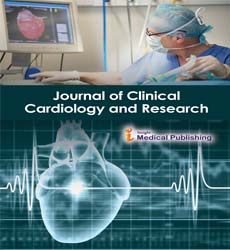Cardiac Implications of Atypical Pulmonary Sarcoidosis: A Radiological Case Report
John Victoria
Department of Cardiology, Lausanne University, Lausanne, Switzerland
Corresponding author:
John Victoria,
Department of Cardiology, Lausanne University, Lausanne, Switzerland;
Email: john@victoria.ch
Received date: January 01, 2025, Manuscript No. ipccr-25-20604; Editor assigned date: January 03, 2025, PreQC No. ipccr-25-20604 (PQ); Reviewed date: January 15, 2025, QC No. ipccr-25-20604; Revised date: January 22, 2025, Manuscript No. ipccr-25-20604 (R); Published date: January 28, 2025, DOI: 10.36648/.8.1.1
Citation: Albert F (2025) Cardiac Implications of Atypical Pulmonary Sarcoidosis: A Radiological Case Report. Clin Res Cardiol J Vol.8 No.1:1
Introduction
Sarcoidosis is a systemic granulomatous disorder of unknown etiology that frequently involves the lungs but can extend to cardiovascular structures, leading to significant morbidity and mortality. While pulmonary involvement typically manifests with bilateral hilar lymphadenopathy and upper lobe predominance, atypical radiological presentations may obscure diagnosis and complicate management. Given that cardiac sarcoidosis remains a leading cause of death in affected patients, early recognition of atypical pulmonary findings through radiology can serve as a crucial window for anticipating and preventing cardiac involvement. This case highlights the role of imaging in identifying an atypical presentation of sarcoidosis with clinical relevance to cardiology and multidisciplinary care [1].
Description
The patient presented with persistent cough, unexplained weight loss, and low-grade fever, with initial suspicion directed toward tuberculosis or malignancy. Chest radiography revealed unilateral parenchymal opacities without hilar lymphadenopathy, which is uncommon for sarcoidosis. High-Resolution Computed Tomography (HRCT) further demonstrated patchy ground-glass opacities and irregular nodules predominantly in the lower lobes, deviating from classical imaging hallmarks. This atypical distribution created diagnostic uncertainty, necessitating broad differential consideration, including infectious etiologies and neoplastic processes [2]. From a cardiology perspective, the diagnostic ambiguity carried heightened importance as sarcoidosis can progress to cardiac involvement, manifesting as conduction abnormalities, arrhythmias, or heart failure. Positron Emission Tomography (PET) scans revealed hyper metabolic activity in pulmonary lesions, mimicking malignancy but also raising suspicion of systemic activity with potential cardiac risk ultimately, biopsy confirmed non-caseating granulomas consistent with sarcoidosis, and the patient was initiated on corticosteroid therapy [3]. This case emphasizes that radiological recognition, even in atypical pulmonary patterns, is essential in anticipating and monitoring for cardiac sarcoidosis. Radiology also provided essential follow-up insights. HRCT and PET-CT imaging after therapy demonstrated regression of pulmonary lesions, correlating with clinical improvement and reduced risk for cardiac progression. This case highlights how multimodal imaging, when interpreted within a cardiopulmonary framework, not only narrows diagnostic possibilities but also informs risk stratification and management strategies to prevent cardiac complications [4]. Longitudinal imaging surveillance remains crucial, as cardiopulmonary interactions often evolve subtly over time and may not be fully captured in early clinical assessments. Regular follow-up with HRCT and PET-CT allows for the timely detection of recurrent or progressive disease, while echocardiography and cardiac MRI complement these modalities by offering detailed insights into myocardial involvement and functional impairment. Integrating these imaging findings with biomarkers and clinical parameters establishes a comprehensive framework for risk monitoring, enabling clinicians to anticipate potential complications such as pulmonary hypertension or right heart failure [5].
Conclusion
This case of atypical pulmonary sarcoidosis illustrates the diagnostic complexity encountered when classical radiological hallmarks are absent. Unilateral and lower lobe-predominant findings initially mimicked infectious or neoplastic disease, delaying diagnosis. However, radiology proved indispensable in guiding both differential diagnosis and follow-up, while also highlighting the importance of vigilance for potential cardiac involvement. Integrating radiological assessment with cardio logical evaluation ensures earlier recognition of systemic sarcoidosis, better prognostication, and optimized patient outcomes in clinical cardiology practice.
References
- Asselin MC, O’Connor JPB, Boellaard R, Thacker NA, Jackson A (2012) Quantifying heterogeneity in human tumours using MRI and PET. Eur J Cancer 48: 447–455
Google Scholar Cross Ref Indexed at
- Anderson NM, Simon MC (2020) The tumor microenvironment. Curr Biol 30: R921–R925
Google Scholar Cross Ref Indexed at
- Nishino M (2019) Perinodular radiomic features to assess nodule microenvironment: Does it help to distinguish malignant versus benign lung nodules? Radiology 290: 793–795
Google Scholar Cross Ref Indexed at
- Kang J, La Manna F, Bonollo F, Sampson N, Alberts IL, et al. (2022) Tumor microenvironment mechanisms and bone metastatic disease progression of prostate cancer. Cancer Lett 530: 156–169
Google Scholar Cross Ref Indexed at
- Andraws R, Berger JS, Brown DL (2005) Effects of antibiotic therapy on outcomes of patients with coronary artery disease: A meta-analysis of randomized controlled trials. JAMA 293: 2641–2647
Open Access Journals
- Aquaculture & Veterinary Science
- Chemistry & Chemical Sciences
- Clinical Sciences
- Engineering
- General Science
- Genetics & Molecular Biology
- Health Care & Nursing
- Immunology & Microbiology
- Materials Science
- Mathematics & Physics
- Medical Sciences
- Neurology & Psychiatry
- Oncology & Cancer Science
- Pharmaceutical Sciences
